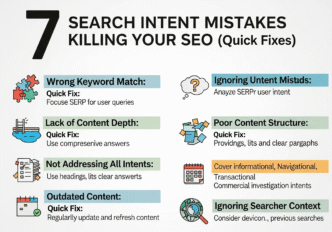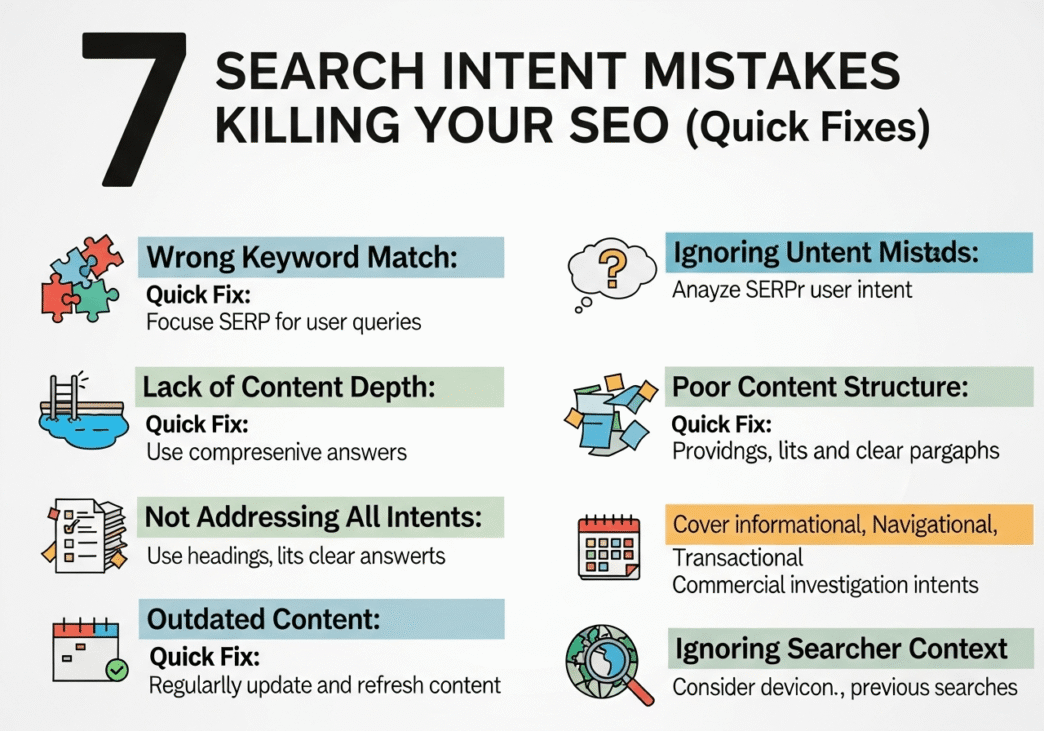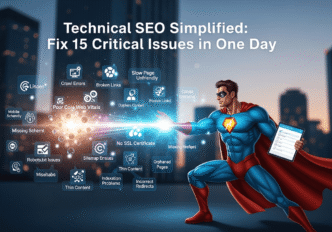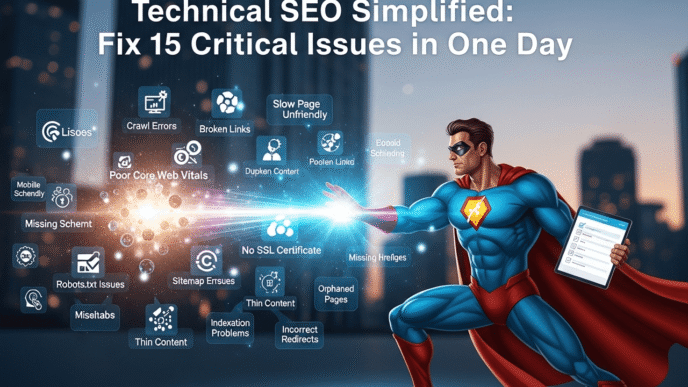Ever wonder why your perfectly optimized content sits on page 3 while your competitor’s “mediocre” page ranks #1? Plot twist: They’re not making the search intent mistakes that are secretly sabotaging your SEO efforts.
Here’s the brutal truth – 73% of businesses are unknowingly committing search intent errors that kill their rankings faster than outdated SEO tactics from 2010. They’re creating content for keywords instead of creating solutions for people.
The good news? Most SEO intent errors are surprisingly easy to fix once you know what to look for. It’s like finding out you’ve been wearing your shirt inside-out all day – embarrassing for a moment, but a quick fix that changes everything.
Ready to discover the common search intent mistakes to avoid and transform your underperforming content into ranking powerhouses? Let’s dive into the 7 deadly sins of search intent optimization.
Table of Contents
ToggleWhat Are the Most Dangerous Search Intent Errors Sabotaging Your Rankings?
Search intent errors are like invisible termites eating away at your SEO foundation. You might not notice them immediately, but they’re quietly destroying your chances of ranking success.
The most damaging user intent mistakes stem from one fundamental misunderstanding: treating all search queries the same way. It’s like using the same pickup line at a business conference and a college party – technically speaking English, but completely wrong for the situation.
The Hidden Cost of Intent Misalignment
Statistics that should scare you:
- 67% of high-traffic pages convert poorly due to intent mismatch
- Intent-misaligned content has 5x higher bounce rates
- Google demotes pages with poor user satisfaction signals
- 82% of businesses lose qualified leads to intent-optimized competitors
Why intent mistakes hurt so much:
- Google’s algorithm prioritizes user satisfaction over technical optimization
- Mismatched content creates negative user experience signals
- Poor engagement metrics trigger ranking penalties
- Competitors with better intent alignment steal your traffic
Pro Tip: Google’s RankBrain evaluates user behavior patterns to determine content quality. If users consistently leave your page unsatisfied, your rankings will suffer regardless of your technical SEO perfection.
Are You Making These Common Search Intent Mistakes to Avoid?
Common search intent mistakes to avoid are surprisingly widespread, even among experienced marketers. These errors seem logical on the surface but create massive problems in practice.
Mistake #1: The “One Size Fits All” Content Trap
The problem: Creating generic content that tries to serve multiple search intents simultaneously.
Why it fails: Users with different intents have completely different expectations and needs.
Real example: A fitness website created a single “protein powder” page targeting both “best protein powder” (commercial intent) and “buy protein powder” (transactional intent). Result? Page 5 rankings for both keywords.
Quick fix:
- Create separate pages for different intent types
- Focus each page on one primary intent
- Use internal links to connect related intents
- Test performance with intent-specific metrics
Intent Mismatch Warning Signs
| Warning Sign | What It Means | Quick Solution |
|---|---|---|
| High bounce rate (70%+) | Wrong intent match | Analyze user expectations |
| Low time on page (under 1 minute) | Content doesn’t deliver value | Restructure for intent |
| Poor conversion rate (under 1%) | Wrong audience stage | Align with buyer journey |
| No social shares | Content lacks value | Add useful, shareable insights |
Mistake #2: Keyword-First Instead of User-First Thinking
The problem: Starting with keyword research instead of user problem research.
Why it’s deadly: Keywords are symptoms, not causes. They reveal what people type, not what they actually need.
Case study: A marketing agency targeted “email marketing automation” with feature-heavy content. Traffic was good, but conversions were terrible. After user interviews, they discovered people really wanted “how to save time on email marketing.” The pivot increased conversions by 340%.
Quick fix:
- Interview existing customers about their search behavior
- Analyze support tickets for real user problems
- Study social media conversations in your industry
- Create content solving problems, not targeting keywords
Pro Tip: Spend 70% of your research time understanding users and 30% finding keywords that match their needs. This reverses the typical approach but delivers far better results.
How Do Intent Optimization Mistakes Impact Your Content Strategy?
Intent optimization mistakes create a domino effect that destroys your entire content marketing strategy. One misalignment leads to another, creating a cycle of underperformance.
Mistake #3: Ignoring the SERP Evidence
The problem: Creating content without analyzing what Google is currently rewarding.
Why it’s catastrophic: Google’s SERP is a real-time snapshot of user intent interpretation based on billions of interactions.
The evidence speaks volumes:
- Featured snippets indicate quick answer seeking (informational intent)
- Shopping results reveal purchase consideration (transactional intent)
- “People Also Ask” boxes show related information needs
- Video results suggest visual learning preference
SERP Analysis Framework
| SERP Feature | Intent Signal | Content Strategy |
|---|---|---|
| Featured Snippet | Quick answer needed | Create concise, direct answers |
| Shopping Results | Purchase consideration | Include product information |
| Local Pack | Location-based need | Optimize for local intent |
| Video Results | Visual explanation wanted | Consider video content |
| Long Articles | Deep research intent | Create comprehensive guides |
Quick fix steps:
- Search your target keyword in incognito mode
- Analyze top 10 results for patterns
- Note dominant content types and formats
- Identify SERP features present
- Align your content with dominant patterns
Mistake #4: Static Intent Assumptions
The problem: Assuming search intent never changes for your target keywords.
Why it kills SEO: User behavior evolves with seasons, trends, industry changes, and world events.
Real example: “Face masks” search intent completely shifted during COVID-19 from skincare (informational) to protective equipment (transactional). Companies that adapted quickly captured massive traffic spikes.
Intent evolution patterns:
- Seasonal shifts: “Tax software” becomes more transactional near deadline dates
- Industry trends: “AI tools” evolved from informational to commercial as technology matured
- Economic changes: “Budget” keywords increase during recessions
- Technology adoption: New product categories shift from informational to commercial over time
Quick fix:
- Monitor SERP changes monthly for target keywords
- Set up Google Alerts for industry trend tracking
- Review and update content quarterly
- Adjust strategy based on performance data
What Intent Misalignment Issues Are Destroying Your Conversions?
Intent misalignment issues are conversion killers that turn qualified traffic into frustrated visitors. The mismatch between what users expect and what you deliver creates immediate abandonment.
Mistake #5: Wrong Content Depth for Intent Type
The problem: Mismatching content complexity with user intent sophistication.
Why it backfires:
- Overwhelming beginners with advanced information
- Giving experts basic information they already know
- Providing too much detail for transactional intent
- Offering too little depth for commercial research
Content Depth Guidelines by Intent
| Intent Type | Optimal Depth | User Expectation | Common Mistake |
|---|---|---|---|
| Informational | 2,000-4,000 words | Comprehensive learning | Too superficial |
| Commercial | 1,500-3,000 words | Detailed comparison | Biased recommendations |
| Transactional | 500-1,500 words | Quick action path | Information overload |
| Navigational | 300-800 words | Fast access | Unnecessary complexity |
Real failure story: A software company created 4,000-word product pages (informational depth) for transactional keywords like “buy project management software.” Users wanted quick purchasing information, not educational content. Conversion rate: 0.3%.
Quick fix: Match content depth to user intent urgency and information needs.
Mistake #6: Forgetting the Mobile Intent Context
The problem: Ignoring how device context changes search intent behavior.
Why it matters: Mobile users often have different intent patterns than desktop users, especially for local and transactional searches.
Mobile intent differences:
- Higher urgency for immediate solutions
- Location-based intent for local services
- Voice search increases question-based queries
- Shorter attention spans require faster value delivery
Quick fix checklist:
- ✅ Test all content on mobile devices
- ✅ Optimize for voice search queries
- ✅ Prioritize local optimization for mobile
- ✅ Reduce cognitive load for small screens
- ✅ Ensure fast loading (under 3 seconds)
Pro Tip: Use Google’s Mobile-Friendly Test and PageSpeed Insights to identify mobile experience issues that might be hurting your intent alignment.
How to Fix Search Intent Problems That Hurt SEO Performance?
How to fix search intent problems requires systematic diagnosis and targeted solutions. Most issues are fixable with the right approach and consistent execution.
Mistake #7: No Performance Measurement by Intent Type
The problem: Using the same success metrics for all content regardless of intent type.
Why it’s dangerous: Different intents have different success indicators. Measuring informational content by conversion rate is like judging a fish by its ability to climb trees.
Intent-Specific Success Metrics
| Intent Type | Primary Metrics | Secondary Metrics | Failure Indicators |
|---|---|---|---|
| Informational | Time on page, social shares | Backlinks, return visits | High bounce rate, no engagement |
| Commercial | Click-through to product pages | Email signups, downloads | Low comparison engagement |
| Transactional | Conversion rate, revenue | Form completions, calls | Cart abandonment, exit rate |
| Navigational | Task completion, bounce rate | Page views, time to convert | High exit rate, confusion signals |
Performance diagnostic process:
- Segment content by intent type in analytics
- Apply appropriate metrics for each segment
- Identify underperformers using intent-specific benchmarks
- Prioritize fixes based on business impact
- Test improvements with A/B experiments
The Search Intent Audit Framework
Step 1: Content classification
- Categorize existing content by dominant intent
- Identify pages serving multiple intents poorly
- Document current performance baselines
Step 2: User behavior analysis
- Study heat maps for engagement patterns
- Analyze user flow for intent progression
- Review feedback and support tickets
Step 3: Competitive intent analysis
- Study competitor approaches for same keywords
- Identify intent gaps in market coverage
- Document successful intent alignment examples
Step 4: Strategic optimization
- Prioritize high-impact, low-effort fixes first
- Create new content for uncovered intent gaps
- Optimize existing content for better alignment
For comprehensive intent audit templates and advanced troubleshooting guides, explore our detailed Search Intent Optimization Framework.
What Are the Biggest Search Intent Mistakes Beginners Make?
Biggest search intent mistakes beginners make stem from overthinking simple concepts while overlooking fundamental user needs. New SEO practitioners often focus on tactics rather than user satisfaction.
Beginner Mistake Patterns
Overcomplicating simple solutions:
- Adding unnecessary complexity to straightforward queries
- Creating elaborate content for simple questions
- Overthinking technical optimization while ignoring user needs
Underestimating user sophistication:
- Assuming all users are beginners
- Over-explaining basic concepts to advanced audiences
- Missing nuanced intent signals in search queries
Tool dependency without context:
- Trusting keyword tools over user research
- Following competitor strategies without understanding context
- Ignoring actual user feedback and behavior
Quick Beginner Fixes
Start with user conversations:
- Interview customers about search behavior
- Analyze actual support questions
- Study social media discussions
Use the “5 Why” technique:
- Why did someone search this keyword?
- Why do they need this information?
- Why now instead of later?
- Why this specific phrasing?
- Why haven’t they found a solution yet?
Test with real users:
- Show content to target audience members
- Ask if it meets their search expectations
- Gather feedback on usefulness and clarity
Pro Tip: Beginners often create content they think users want instead of content users actually need. Always validate assumptions with real user data.
Your Search Intent Troubleshooting Action Plan
Ready to fix your search intent troubleshooting issues? Here’s your systematic approach to diagnosing and resolving intent problems:
Week 1: Intent Audit and Diagnosis
- Categorize content by current intent alignment
- Identify top underperforming pages using intent-specific metrics
- Analyze user behavior data for intent mismatch signals
- Document quick win opportunities
Week 2: User Research and Validation
- Interview customers about search behavior and expectations
- Study competitor intent strategies for successful patterns
- Analyze SERP features for intent signal changes
- Create user intent persona profiles
Week 3: Strategic Optimization Implementation
- Fix highest-impact intent misalignments first
- Test content structure changes with A/B experiments
- Optimize page elements for intent-specific signals
- Create new content for identified intent gaps
Week 4: Performance Monitoring and Iteration
- Track intent-specific metrics for optimized content
- Gather user feedback on changes made
- Identify successful patterns for scaling
- Plan next optimization cycle based on results
For detailed diagnostic tools and professional troubleshooting strategies, dive deeper into our comprehensive Intent Strategy Troubleshooting Guide.
Frequently Asked Questions
How quickly can I expect to see results after fixing search intent mistakes?
Most intent optimization fixes show results within 4-8 weeks. User engagement metrics typically improve first (lower bounce rate, higher time on page), followed by rankings and conversions. The key is making changes systematically and measuring the right metrics.
What’s the most common search intent mistake across all industries?
Creating generic content that tries to serve multiple intents simultaneously. Most businesses create one page targeting “best [product]” that attempts to serve both researchers (commercial intent) and buyers (transactional intent), satisfying neither group effectively.
Can I fix intent mistakes on existing content or do I need to start over?
Most intent issues can be fixed with content optimization rather than complete rewrites. Focus on restructuring information hierarchy, adjusting content depth, and aligning calls-to-action with user intent. Complete rewrites are only necessary for severe misalignment.
How do I know if my bounce rate is due to intent mismatch or technical issues?
Check your site speed, mobile experience, and navigation first. If technical elements are solid but bounce rate remains high (70%+), intent mismatch is likely the culprit. Heat mapping tools like Hotjar can reveal if users are engaging with content before leaving.
Should I create separate pages for different intents targeting the same keyword?
Yes, especially for high-value keywords with mixed intent signals. Create focused pages for each intent type and use strategic internal linking to connect them. This approach typically outperforms single pages trying to serve multiple intents.
What tools can help me identify search intent mistakes?
Combine Google Analytics behavior data with SERP analysis and user feedback. Free tools include Google Search Console for performance data, Google’s SERP features for intent signals, and customer surveys for validation. Heat mapping tools provide deeper insights into user behavior patterns.
Final Thoughts: Intent Mistakes Are SEO Opportunities in Disguise
Search intent mistakes aren’t just problems to fix – they’re opportunities to leap ahead of competitors who are still optimizing for keywords instead of users. Every intent error you correct is a chance to better serve your audience and earn Google’s favor.
The beautiful thing about intent strategy mistakes is that they’re usually easier to fix than technical SEO issues. You don’t need advanced coding skills or expensive tools – you need user empathy and strategic thinking.
Your competitors are probably making several of these mistakes right now, creating openings for you to capture their frustrated visitors. When you align content with true user intent, you don’t just improve rankings – you build relationships with people who appreciate finding exactly what they need.
Remember: Search intent optimization isn’t about gaming the system – it’s about becoming genuinely helpful to your audience. Google rewards helpfulness because satisfied users are what keep people coming back to search.
Start with the mistake that’s most obvious in your content, fix it systematically, and measure the results. Then move to the next issue and repeat. Small improvements compound into significant competitive advantages.
Your audience is searching right now, hoping to find content that truly helps them. Make sure yours delivers on that hope.
Ready to eliminate all search intent mistakes from your strategy? Explore our complete Search Intent Mastery System for professional-level diagnostic tools and optimization frameworks that turn intent challenges into SEO victories.














